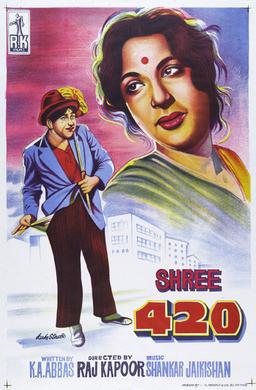Decoding Shree 420 (1955)
Movie no. 7/100
May 5, 2018
With the seventh movie in my
movie challenge, I went back to the black-and-white era! I picked the
1955
blockbuster, Shree 420, with Raj Kapoor and Nargis in the lead. Directed and Produced
by Raj Kapoor, Shree 420 is a social drama about the rich in the newly freed
India exploiting the poor. It is a light-hearted take on the economic disparity
that existed in our society, though it has considerably narrowed now.
Raj (played by Raj Kapoor) is a
poor Allahabadi who arrives in Mumbai
to earn a living, armed only with a degree in BA and a medal of honesty. He is
honest, hard-working and innocent when he arrives in the Maximum City, but
soon, reality strikes him. He meets Vidya (played by Nargis), a young,
righteous school teacher, who is the only bread-winner after her father is
rendered wheel-chair ridden. After a couple of odd jobs and a parallel love
track with Vidya, Raj is introduced to the world of glitz and glam by a sultry,
rich con-woman, Maya (played by Nadira). Raj is soon seduced by the greed and
riches, and gets into earning them through unethical means. He is made an accomplice
in a ponzi scheme by a shrewd businessman, Seth Sonachand (played by Nemo), where
they cheat the public to amass more than a crore (a huge amount back in the
day, when gold was, apparently, 80 rupay
ka tola). But Raj’s conscience and Vidya’s barbs engulf him with guilt,
which make him leave the miserable life of riches and reunite with Vidya.

Raj Kapoor is hailed as the greatest showman
of Indian Cinema and Shree 420 is considered one of his major works. His antics
in the first half mimic Charlie Chaplin – the use of hat, a stick in his hand
and loud expressions. He explains it beautifully as a mask that he wears to
hide his sorrows. The mask also symbolizes the fake face of benevolence that
the shrewd rich men wear to deceive the poor. Raj Kapoor, as a director, tries
to evoke certain emotions by using an alternate narrative. One of my favorites
is the scene where he shows two hands with wads of cash and Nargis in between,
expressing her disgust at the greed of her beloved. Another favorite of the
filmmakers in the 50s, was to make the conscience of a person speak to them –
depicted onscreen as a conversation between the character and his image in the
mirror (Raj Kapoor) or a ghostly silhouette (Nargis). It would have been fascinating
for the viewers in the 1950s, since the technology was primitive in that age.
Nargis plays a righteous, demure,
girl-next-door who holds her head high and stands by her principles. Like
Gayatri Joshi in my last movie in this challenge, Swades, Nargis acts as a catalyst
to bring her beloved back to senses. She is beautiful and restrained. Nadira
plays the quintessential hindi-film ‘vamp’ – stylish, cunning and a seductress.
She uses her sky-high brows and haughty stance to play the evil lady perfectly.
The supporting cast, headlined by Lalita Pawar in a positive role, support the
story well. Raj Kapoor, playing Raj, carries the film with aplomb! He is extremely
expressive as a Chaplin clown and equally good as the forlorn man torn between luxuries
and ethics. It would be incomplete to talk about the movie and not mention its
superb soundtrack by Shankar-Jaikishan. This movie gave us some of the biggest
chartbusters and an iconic – Pyaar Hua Ikraar Hua.
I have two more Raj Kapoor
masterpieces in my list – Awaara and Mera Naam Joker. Going by the start, I
cannot wait to watch these two 😊
Comments
Post a Comment